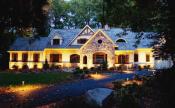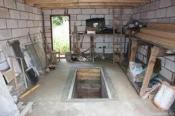Search
Login
Shade-loving and shade-tolerant plants for the garden, how to choose the right one, planting shade-loving plants in the garden, caring for shade-loving plants
More recently, the first stage of any construction and subsequent landscaping was the complete destruction of existing trees on the site. In a later time period, due to the triumph of common sense and pragmatism, or simply paying tribute to fashion, landowners hit the other extreme, according to which leaving as many adult trees as possible was a sign of good taste. But this did not affect the existing principles of landscape design in any way, and, as before, English lawns, Spanish roses and many other types of landscaping, fashionable abroad, were still in fashion.
Content
- Shade-loving plants. Determine the illumination of the garden video
- Concepts of dry and wet shadow.
- The variety of life forms of shade-tolerant plants
- Shade-loving plants. Key Representatives
- Original ideas for arranging a shady garden. continuous flowering garden
- Shade Care
Shade-loving plants. Determine the illumination of the garden
In this regard, it became necessary to select plants that should not only meet all the principles of decoration, but also for which shadow and partial shade will become a favorable habitat. This stage of landscaping the countryside will be the subject of this article. Before moving on to arranging a shady garden, you need to familiarize yourself with some recommendations.
According to recommendations for gardeners, the intensity and duration of the solar light flux are decisive factors in determining the illumination or shade of any area of \u200b\u200bthe garden. However, they are not constant and may vary depending on the duration of daylight hours, time of year and the height of the sun. In accordance with combinations of various natural factors, the zonality of the garden can be represented as follows:

1. The territory, fully lit, or full sun, the sun is observed for no more than 3 hours a day (direct midday sun);
2. The territory of penumbra is highlighted if this area is illuminated by direct sunlight in the morning or evening for about 3 hours, in the middle of the day there is a shadow, or uniform illumination without direct sunlight throughout the day;

3. The territory completely in the shade, or full shade, is characterized by 3-hour lighting in direct sunlight and limited illumination in other hours;
4. The territory of the rarefied shadow is determined if sunlight penetrates the site through any partial obstacle or foliage.

Concepts of dry and wet shadow.
Knowledge of the zoning of the territory is necessary for the optimal selection of shade-loving and shade-tolerant plants. Experts also advise to distinguish between the concepts of dry and wet shade, since this is also important for optimal landscaping.

The territory densely planted with large old trees is a prerequisite for the formation of an arid shade, since their well-developed root system almost completely absorbs soil moisture, forming its lack.
If the soil soil has the ability to retain moisture, and there are no obstacles to the penetration of rain, a wet shadow forms, which has its drawbacks and advantages.

There are many ideas for decorating shady gardens, and plants for such gardens are diverse. Depending on the light preferences of the vegetation, first of all, shade-loving plants are distinguished from shade-tolerant plants.
The variety of life forms of shade-tolerant plants
Shade-tolerant crops feel great both in the bright shade formed by pine and birch, and in partial shade, where their development reaches its peak. The dense shadow created by the branches of fir trees is also one of the optimal places for the growth of shade-tolerant species. By the method of use in decorative compositions and the nature of surface growth, shade-tolerant plants for the garden are distinguished by a variety of life forms, among which:

1. creeping ground cover, the main representatives of which are bitterness, tiara hearty, hoofed tailed;
2. stunted curbs, among which Jeffersonia can be noted;
3. medium and tall shingles, buzulnik, telekii and many other forms of habitat.

If your site is distinguished by a sufficiently strong dimming, then you can safely count on the decorative elecampane magnificent, arisema, astilbe and bought, and if the shadow on the site is quite bright, it is perfectly diversified by daylilies, lupins, medunica, aromatic woodruff, which are medicinal crops, as well medicinal herbs, including peppermint and lemon balm.

Shade-loving plants. Key Representatives
There are also such cultures for which growth in the shade is not only optimal, but also a prerequisite for normal life. Such species are called shade-loving, since light is more destructive for them. When choosing shade-loving plants for a garden among perennials, you can choose aquilegia, asperula or woodruff, goryanka, dicenter and iris; among shrubs, pointed gaulteria or action. They will be a great choice for areas with dry shade. If the shadow on the plot is wet, then you will not be mistaken if you choose ordinary aruncus, large-leafed brunner, multi-colored euphorbia, heart-shaped tiarella or large-flowered trillium.


There are many original ideas for arranging a shady garden, using which you will become the owner of an original design composition.
Original ideas for arranging a shady garden. Garden of continuous flowering
A garden located in the kingdom of shade, like well-lit, can be made a garden of continuous flowering. To implement this plan, you can choose a whole assortment of flowering shade-loving plants and thereby ensure the continuity of flowering, which is achieved by combining them.

One of the main combinations that provide constant flowering of the garden is a combination of small bulb and large bulb plants. The main representatives of the small onion are muscari, montbrecia, snowdrop, crocosmia, the main value of which is considered not the duration of flowering, but early flowering. Following the small-bulbous race, daffodils, tulips and hyacinths, called large-bulbous trees, planted before winter, will take over the race, which will provide the desired flowering continuity.

Another idea of \u200b\u200bconstant flowering, designed to destroy existing stereotypes, is a combination of large onions with perennials. Contrary to all prevailing stereotypes, the penumbra is the optimal place for planting daffodils and hyacinths, where they reach their greatest flowering, and after the bulbous plants bloom, the garden will be decorated with perennials planted with them. The ideal combination in this case will be tulips planted together with forget-me-nots or marigolds, since the latter will successfully cope with the masking of faded bulbous.

There is another original idea of \u200b\u200bcombining shade-loving garden plants, which allows providing a beautiful contemplative panorama regardless of the time of year. Evergreen perennials, such as ivy, tiarella and pahzander, covering the soil even in winter, in combination with flowering summers, will create a composition resembling a patchwork patchwork style in which various textures and color schemes are combined.

Shade Care
Most shade-loving and shade-tolerant plants prefer fertile and loose soil, and that is why the soil must be carefully prepared before planting such plants. The main stages of preparation are the removal of weeds without chemicals and the further improvement of the soil by adding sand and peat. The garden, arranged in the shade of trees, has a feature due to which a fertile soil layer is constantly formed. This feature is the annual fall of leaves, which, decaying, form the nutrient layer of humus. As a result of this, it is not recommended to dig a near-trunk layer of soil. Another agrotechnical measure that provides proper care for shade-loving plants is timely watering. Observing all the above features of agricultural technology, you will become the owner of flower beds, pleasing beauty and abundant flowering.






